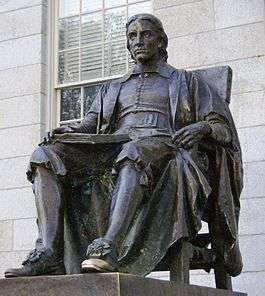Oakes Ames (botanist)

Oakes Ames (/eɪms/; September 26, 1874 – April 28, 1950) was an American biologist specializing in orchids.[1] His estate is now the Borderland State Park in Massachusetts.
Life and career
Ames was born into a wealthy family from North Easton, Massachusetts as the youngest son of Governor Oliver Ames. At age fifteen, he collected his first orchids in Easton. He was educated at Harvard University, receiving his A.B. in Biology in 1898 and his A.M. in 1899 in Botany. He married Blanche Ames (no relation) in 1900, resulting in her married name of Blanche Ames Ames.

Ames spent his entire professional career at Harvard. As administrator, he was Assistant Director (1899–1909) and Director of the Botanic Garden (1909–1922); Curator (1923–1927), Supervisor (1927–1937), Director (1937–1945), and Associate Director of the Botanic Museum (1945–1950); Chairman of the Division of Biology (1926–1935) and Chairman of the Council of Botanical Collections and Supervisor of the Biological Laboratory, the Atkins Garden in Cuba, and the Arnold Arboretum (1927–1935). As teacher, he was an instructor in botany (1900–1910), associate professor of botany (1915–1926), professor of botany (1926–1932) and Arnold professor of botany (1932–1935). From 1935 to 1941 he was a research professor of botany. He was elected a Fellow of the American Academy of Arts and Sciences in 1911.[2]
The Orchidaceae were little-known before Ames' study and classification. He made expeditions to Florida, the Caribbean, the Philippines, and Central and South America, with his wife Blanche Ames Ames creating scientifically accurate drawings of the plants they cataloged. The Ames' work was published in the seven-volume Orchidicae: Illustrations and Studies of the Family Orchidicae. They also developed the Ames Charts, illustrating the phylogenetic relationships of the major useful plants, which are still used.
Orchid Herbarium and the Glass Flowers
Ames built up an extensive orchid herbarium, with library, photographs, and paintings, which he gave to Harvard in 1938. Today the Orchid Herbarium of Oakes Ames contains about 131,000 specimens, plus 3,000 flowers in glycerine, 4,000 pickled specimens, and hundreds of line drawings. Its library includes about 5,000 books, reprints, and journals. This orchid Herbarium would eventually be integrated into the larger Harvard University Herbaria as Ames succeeded Professor George Lincoln Goodale as the director of Harvard's Botanical Museum (now the Harvard Museum of Natural History).[3] As the museum's second director (Goodale had been the first), he oversaw the final stages of the creation of the famous Glass Flowers collection, exchanging a letter with the patron sponsor of the enterprise, Miss Mary Lee Ware during her second visit to Dresden, Germany visiting Rudolf Blaschka, one of the Flower's makers.[4][5] This missive to Professor Ames was published in January 9, 1961 by the Harvard University Herbaria - Botanical Museum Leaflets, Harvard University Vol. 19, No. 6 - under the title "How Were The Glass Flowers Made?" and details some of Miss Ware's observations regarding Rudolf.[6]
References
- ↑ "AMES, Oakes". The International Who's Who in the World. 1912. p. 26.
- ↑ "Book of Members, 1780-2010: Chapter A" (PDF). American Academy of Arts and Sciences. Retrieved 17 April 2011.
- ↑ Harvard University Herbaria & Libraries (Oakes Ames Orchid Herbarium (AMES)) - http://huh.harvard.edu/pages/oakes-ames-orchid-herbarium-ames
- ↑ Schultes, Richard Evans., William A. Davis, and Hillel Burger. The Glass Flowers at Harvard. New York: Dutton, 1982. Print.
- ↑ Daston, Lorraine. Things That Talk: Object Lessons from Art and Science. New York: Zone, 2004. Print.
- ↑ Ware, Mary Lee. "HOW WERE THE GLASS FLOWERS MADE?" Botanical Museum Leaflets, Harvard University 19, no. 6 (1961): 125-36. - http://www.jstor.org/stable/41762212
- ↑ IPNI. Ames.
- Donovan S. Correll, Review of Oakes Ames. Jottings of a Harvard Botanist by Pauline Ames Plimpton and George Plimpton. Brittonia, Vol. 32, No. 2 (Apr. - Jun., 1980), pp. 276–278.
- Karl Sax,"Oakes Ames, 1874-1950", Journal of the Arnold Arboretum, 31, pages 335-337.
- Borderlands: Oakes Ames
- Harvard University: Oakes Ames Orchid Herbarium
External links
- Papers of Oakes Ames : an inventory (Harvard University Archives)
- Letter in the Woman's Rights Collection, 1918: A Finding Aid.
- Schlesinger Library, Radcliffe Institute, Harvard University.
- How Were The Glass Flowers Made?
